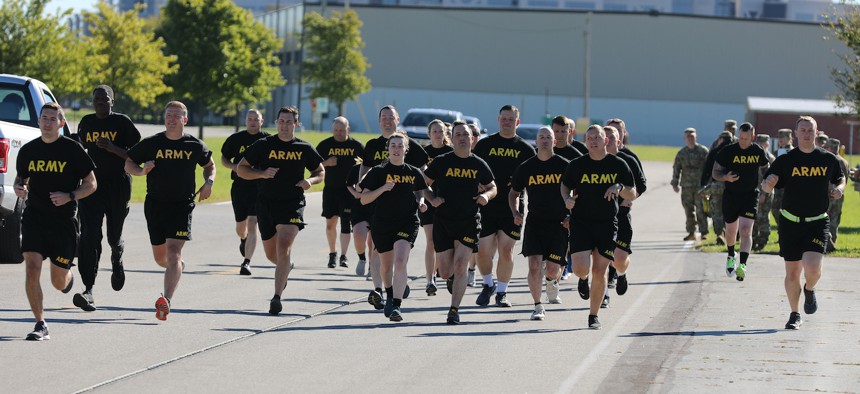
U.S. Army Soldiers assigned to the 37th Infantry Brigade Combat Team conduct the 2-Mile Run event of the Army Combat Fitness Test at the Defense Supply Center Columbus, Ohio, Sep. 23, 2022. U.S. Army / Staff Sgt. Scott Fletcher
Army Mulls New Tool to Track Soldier Readiness
A pilot of the tool allowed 18th Airborne Corps first sergeants to spend 80 percent less time in the office.
The Army’s non-commissioned officers may start using an online dashboard to track soldiers' readiness, after a pilot study showed the move could reduce paperwork and improve training outcomes.
The tool, called the Unit Leader Workspace, tracks individual soldiers’ completion of a range of readiness goals, including medical checks, administrative requirements, and training tasks, such as weapons qualifications. The tool also includes calendar functions that allow commanders to quickly see if their formations will be ready in time for deployment.
The tool is available Army-wide, but so far has only been made mandatory for the 18th Airborne Corps, which includes the 82nd Airborne Division, the 101st Airborne Division, the 10th Mountain Division, and the 3rd Infantry Division.
T.J. Holland, the program manager for the tool and the command sergeant major of the 18th Airborne Corps, said Unit Leader Workspace has improved productivity by cutting down the time non-commissioned officers spend collating data.
In the first six months of using the program, the 18th Airborne found first sergeants spent 80 percent less time in the office, Holland said. First sergeants are among the most senior non-commissioned officers and have a direct role in managing soldiers’ welfare.
More time out of the office also led to better training results, Holland said, as senior non-commissioned officers spent more time with soldiers and less time behind desks.
While the tool is currently experimental, Holland thinks it’s likely to be adopted Army wide. About 84 percent of users access the tool at least once a week within the 18th Airborne, and National Guard and Army Reserve units have begun using it as well.
Current Sergeant Major of the Army Michael Grinston and Grinston’s replacement, Mike Weimer, also support the tool, Holland said “We're postured to survive.”
In a live demonstration at an annual in-person meeting of the Army’s most senior enlisted troops, the tool appeared to load quickly and operate smoothly, allowing users to quickly generate PDFs and Excel spreadsheets showing where a unit is lagging behind.
Units can also use the tool to compete on various readiness tasks, including creating fitness score leaderboards and using those to arrange competitions.
As more organizations embrace big data to track their employees, some experts caution about mental health pitfalls. Research has shown that workers who are regularly tracked with electronics report higher levels of stress. Amazon Warehouse workers whose movements are tracked digitally, for example, reported not using restrooms to avoid being penalized for taking too much time off work.
While the Unit Leader Workspace doesn't envision that level of tracking, one member of the gathering of Nominative Command Sergeants Major noted the Army should be careful to not let the round-the-clock benefit of data analytics create a toxic atmosphere of competition within units.
“I’m pretty sure in this room we don’t want ChatGPT doing our jobs,” one command sergeant major said, adding that some of his soldiers already complain about stress from being constantly monitored and evaluated. The Army asked Defense One to withhold the CSM’s name to allow more open discussion.
“If we’re living in fear of what our data says,” he said, “we take something that should make us more lethal and better, and we turn it into something that could harm us.”
